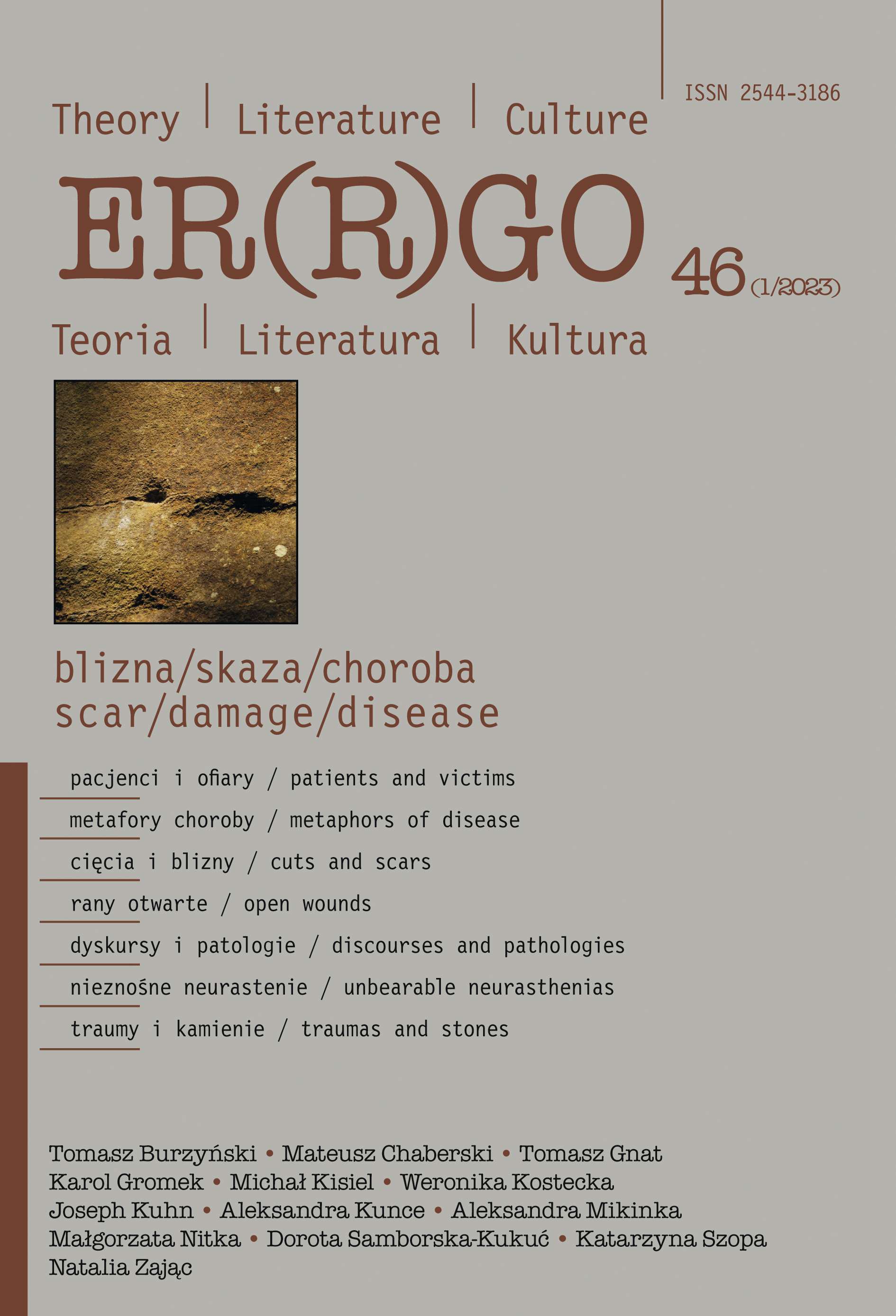Adamczewska-Baranowska, Izabella. “Wirusocentryczne narracje reporterskie z nurtu “mrocznej biologii””. Zagadnienia Rodzajów Literackich 3 (2020), 9–25.
Google Scholar
Cheah Pheng, Spectral Nationality: Passages of Freedom from Kant to Postcolonial Literatures of Liberation (New York, Chichester: Columbia University Press), 2003.
Google Scholar
Crutzen, Paul J., Eugene F. Stroemer. “The ‘Anthropocene’”. Global Change Newsletter 41 (2000), 17–18.
Google Scholar
De Wolff, Kim. “Plastic Naturecultures: Multispecies Ethnography and the Dangers of Separating Living from Nonliving Bodies”. Body & Society 20, 10 (2017), 1–25.
Google Scholar
Haider, Najmul, Peregrine Rothman-Ostrow, Abdinasir Yusuf Osman, Liã Bárbara Arruda, Laura Macfarlane-Berry, Linzy Elton, Margaret J. Thomason, Dorothy Yeboah-Manu, Rashid Ansumana, Nathan Kapata, Leonard Mboera, Jonathan Rushton, Timothy D. McHugh, David L. Heymann, Alimuddin Zumla, Richard A. Kock. “COVID-19-Zoonosis or Emerging Infectious Disease?”. Frontiers in Public Health 8 (2020), https://www.frontiersin.org/articles/10.3389/fpubh.2020.596944/full (20.02.2022).
Google Scholar
Hogan, Chuck. The Blood Artists. New York: William Morrow, 1998.
Google Scholar
Jaque, Andrés, Marina Otero Verzier, Lucia Pietroiusti, red. More-than-Human. Amsterdam–London: Het Nieuwe Instituut, Serpentine Galleries, Manifesta Foundation, 2020.
Google Scholar
Latimer, Joanna. “Being Alongside: Rethinking Relations amongst Different Kinds”. Theory, Culture & Society 30 (2013), 77–104.
Google Scholar
Latour, Bruno. Nadzieja Pandory. Eseje o rzeczywistości w studiach nad nauką, przeł. Krzysztof Abriszewski. Toruń: Wydawnictwo Naukowe Uniwersytetu Mikołaja Kopernika, 2013.
Google Scholar
Latour, Bruno. “Agency at the Time of the Anthropocene”. New Literary History 45 (2014), 1–18.
Google Scholar
Latour, Bruno. Nigdy nie byliśmy nowocześni. Studium z antropologii symetrycznej, przeł. Maciej Gdula. Toruń: Wydawnictwo Naukowe Uniwersytetu Mikołaja Kopernika, 2011.
Google Scholar
Lowe, Celia. “Viral Clouds. Becoming H1N1 in Indonesia”. Cultural Anthropology 25, 4 (2010), 625–649.
Google Scholar
Lunstrum, Elizabeth, Neel Ahuja, Bruce Braun, Patricia J. Lopez, Rebecca W.Y. Wong, Rebeca Collard. “More-than-Human and Deeply Human Perspectives on COVID-19”. Antipode 53, 5 (2021), 1503–1525.
Google Scholar
Quammen, David. Spillover. Animal Infections and the Next Human Pandemic. New York–London: W. W. Norton & Company, 2013.
Google Scholar
Rutz, Christian, Matthias-Claudio Loretto, Amanda E. Bates, Sarah C. Davidson, Carlos M. Duarte, Walter Jetz, Mark Johnson, Akiko Kato, Roland Kays, Thomas Mueller,
Google Scholar
Richard B. Primack, Yan Ropert-Coudert, Marlee A. Tucker, Martin Wikelski and Francesca Cagnacci. “COVID-19 Lockdown Allows Researchers to Quantify the Effects of Human Activity on Wildlife”. Nature Ecology and Evolution 4 (2020), 1156–1159.
Google Scholar
Sampson, Tony D., Virality. Contagion Theory in the Age of Networks. Minneapolis and London: University of Minnesota Press, 2012.
Google Scholar
Schechner, Richard. Performatyka. Wstęp, przeł. Tomasz Kubikowski. Wrocław: Ośrodek Badań Twórczości Jerzego Grotowskiego i Poszukiwań Teatralno-Kulturowych, 2006.
Google Scholar
Searle, Adam, Jonathon Turnbull, Jamie Lorimer. “After the Anthropause: Lockdown Lessons for More-than-Human Geographies”. The Geographical Journal 1 (2021), 69–77.
Google Scholar
Singer, Merill. Introduction to Syndemics. A Critical Systems Approach to Public and Community Health. San Francisco: Jossey-Bass, 2009.
Google Scholar
Strathern, Marilyn. Relations. An Anthropological Account. Durham and London: Duke University Press, 2020.
Google Scholar
Sugiera, Małgorzata. Syndemiocen, czyli antropocen opisany językiem pandemii, źródło niepublikowane.
Google Scholar
The Rain, reż. Kenneth Kainz, Natasha Arthy. Netflix, Dania, 2018–2020.
Google Scholar
Tsing, Anna, “More-than-Human Socialities. A Call for Critical Description”. W: Anthropology and Nature, red. Kirsten Hastrup, 27–42. New York and London: Routledge, 2013.
Google Scholar
Tsing, Anna. “When the Things We Study Respond to Each Other. Tools for Unpacking the ‘Material’”. W: More-than-Human, red. Andrés Jaque, Marina Otero Verzier, Lucia Pietroiusti, 16–21. Amsterdam–London: Het Nieuwe Instituut, Serpentine Galleries, Manifesta Foundation, 2020.
Google Scholar
Wald Priscilla. Contagious. Cultures, Carriers and the Outbreak Narratives. Durham and London: Duke University Press, 2008.
Google Scholar
Waterton Claire, Kathryn Yusoff. “Indeterminate Bodies: Introduction”. Body & Society 20, 10 (2017), 1–20
Google Scholar


 https://doi.org/10.31261/errgo.13406
https://doi.org/10.31261/errgo.13406

 10.31261/errgo
10.31261/errgo